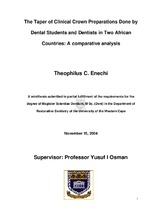| dc.description.abstract | Crowns have been used since the 5th century AD to improve both the form and function of teeth in the mouth. A great proportion of the total expenditure on dental care is spent on the provision and replacement of crowns and bridges and the number is increasing every year. A full coverage crown is a restoration placed over a single prepared tooth or it acts as an abutment in a bridge for the restoration of a missing tooth or teeth. Crowns are considered successful only when they meet both the aesthetic and functional requirements of the patient. For these to be met, certain principles for the preparation of the abutment tooth must be adhered to; such principles include features that are incorporated in the tooth preparation that enable it to withstand the forces of dislodgement that the tooth is exposed to both at rest and function. These features are described as the retention and resistance form of the preparation and the important aspect of these is taper. The taper of a tooth preparation is inversely proportional to the retention provided by the preparation. Volumes have been written on the difficulties encountered in making crowns with an adequate taper. Training, experience and operating conditions are among the many determinants of taper obtained by clinicians. Taper values of 2º to 5º were recommended initially for successful crown restorations but over time it was realized that these values were difficult to achieve under clinical conditions without creating undercuts in the preparation. Besides it was shown that even higher taper values might provide adequate retention for crowns. In addition, extra-retentive features such as axial grooves and boxes have been shown to improve retention of crowns. Many of the new luting cements also have adhesive properties that contribute to better retention of crowns and bridges. Various studies have established the prevalent taper obtained by dental students, general practice dentists, residents and prosthodontists while some of these studies have compared the prevalent taper among the different categories of clinicians. None of the studies so far reported has shown the prevalent taper in this environment; all without exception have investigated conditions in Europe, North America and Asia. Aim: This study therefore investigated the prevalent taper obtained routinely under clinical conditions by dental students, general dental practitioners and prosthodontists in two African countries and compared them with the recommended range of 10º to 22º.Method: 432 dies of teeth prepared by students, general practice dentists, resident and practicing prosthodontists were collected and analysed for taper using the double silicone technique. This involved making silicone replicas of the dies, sectioning these at various points and using photographs of the sections to measure their taper. Comparisons of the tapers obtained were carried out between the students, general practitioners and prosthodontists as well as between taper obtained on the different tooth types. Results: Taper ranging from 2º to 100º was obtained on the various tooth types. A mean mesio-distal (MD) and bucco-lingual (BL) taper of 22.5º (SD 11.2) and 26.2º (SD 11.1) respectively and a mean overall taper of 24.3º (SD 9.2) were obtained. Prosthodontists obtained the lowest taper (MD = 20.5º (SD 10.6)), BL = 24. 5º (SD 10.1) and a mean overall taper of 22.5º (SD 8.4). Students were second with a mean MD taper of 23.8º (SD 10.1), BL taper of 26.1º (SD 10.9) and a mean overall taper of 25.0º (SD 8.4). The general practice dentists obtained a mean MD and BL taper of 24.5º (SD 12.4) and 29.1º (SD 12.1) respectively and a mean overall taper of 26.8º (SD 10.6). The lowest taper was seen on premolars while the highest was on molars. Conclusion and recommendation: Most of the preparations analysed had a taper outside the recommended range of 10º to 22º. However, these tapers were similar to those found in other studies. Routinely incorporating extra-retentive features into crown preparation designs will improve success of crown restorations and adhesive cements should be used whenever conditions that allow for adequate retention are not met. The importance of taper should be emphasized more in dental schools and tooth preparation support systems should be used for teaching wherever possible. The need for regular refresher courses for practicing dentists and prosthodontists cannot be over-emphasized. | en_US |

